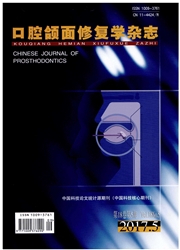

 中文摘要:
中文摘要:
目的:对比赝复体修复后上颌骨缺损患者和正常成年人对照组咀嚼运动时脑血流状况的差异。方法:选取因肿瘤手术切除导致上颌骨缺损的患者16例,手术恢复后采用中空式阻塞器型整体式赝复体修复,作为实验组;另选择16名完整牙列志愿者为对照组。应用经颅多普勒超声探测仪,测量两组在不咀嚼、空咀嚼5min、10min三个时段的大脑中动脉(MCA)收缩期峰流速(Vs)、舒张期末峰流速(Vd)、平均峰流速值(Vm)。进行方差分析和样本均数两两比较的q检验。结果:病例组除在咀嚼5min和10min的Vs数值与对照组无显著性差异外(P〉0.05),其余各组均数的差异均具有统计学意义(P〈0.05)。组间效应方差分析显示,分组因素对Vs、Vd无统计学意义(P〉0.05),对Vm的影响有统计学意义(P〈0.05)。在各时间段上,对照组的Vs、Vd、Vm高于病例组(P〈0.05)。结论:咀嚼运动对赝复体修复后的上颌骨缺损患者及完整牙列受试者的大脑中动脉血管充盈度增加均有一定的促进作用。上颌骨缺损患者中空式阻塞器型赝复体修复后,在咀嚼运动时大脑中动脉Vs和Vd接近完整牙列受试者,Vm低于完整牙列受试者。
 英文摘要:
英文摘要:
Objective: To study cerebral blood velocity during mastication in maxillary defect patients with prosthesis and complete dentition persons. Methods: After prosthesis repaired, 16 patients with maxillary defect due to tumor resection and 16 complete dentition persons were selected. Shrink of peak velocity (Vs), end-diastolic peak velocity (Vd), average peak velocity values (Vm) of middle cerebral artery (MCA) were measured by transcranial Doppler ultrasound detector. Twogroups were measured including three periods respectively, i.e. 0min, 5rain, 10min after empty mastication. Variance analysis andq-test was analyzed. Results: Excepting Vs values of chewing 5rain and 10min were not significantly different from those of the control group, there was significant diffe'rence in Vs, Vd and Vm between two groups (P〈0.05). Analysis of variance between groups showed that, grouping factor had no significant impact to Vs, Vd (P〉0.05) and had significant impact to Vm (P〈0.05). At the same point in mastication time, Vs, Vd, Vm values of control group were higher than that of case group. Conclusion: Mastication can promote the velocity of the middle cerebral artery in bothmaxillary defect pa-tients with prosthesis repair and complete dentition persons. Comparing patients with prosthesis repair with complete denti- tion persons, There is no significant difference in Vs and Vd values, and significant difference in Vm values.
 同期刊论文项目
同期刊论文项目
 同项目期刊论文
同项目期刊论文
 期刊信息
期刊信息
